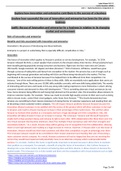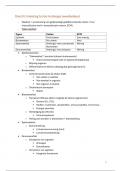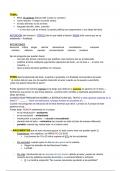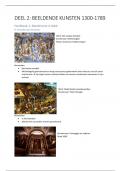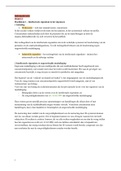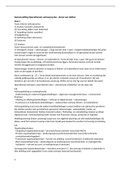Chapter 1: The digital environment
1.1: Introduction
This first chapter considers some of the aspects of technological development that will, or already do,
impact on the digital marketer. They are generic (algemeen) in nature in that they are not marketing
subjects, but they have either (a) an impact on marketing, or (b) can be used by marketers in the
practice of their craft.
Simply put, marketing is managing profitable relationships, by attracting new customers by superior
value and keeping current customers by delivering satisfaction. Marketing must be understood in the
sense of satisfying customer needs. Marketing can be defined as the process by which companies
create value for customers and build strong customer relationships to capture value from customers in
return.
1.2: Digital transformation
Digital transformation has become the term that indicates how the entire organisation has adopted,
adapted to – or ignored – the changes brought to society by the digital revolution. In attempting to
define digital transformation, Fitzgerald et al. (2013) suggest it encompasses the use of new digital
technologies to enable major business improvements (such as enhancing customer experience,
streamlining operations or creating new business models).
It is agreed, however, that for any organisation to digitally transform, that transformation has to:
- be organisation wide
- be understood by everyone in the organisation
- involve everyone in the organisation
- be cultural and not forced
- have no end date.
An effective digital transformation cannot be undertaken by one area or department of the
organisation. Furthermore, digital transformation is not about technology, it is about the strategic use
of technology.
Key components of the digital transformation include: big data, reverse marketing, mobile
applications, the Internet of things and the automation of business processes. Let’s consider each in
more detail.
Big data: is the collection of data from and about everything internal and external to the organisation
and its interpretation to help make the business run more efficiently and improve customer service
▪ Tracking customers and their communications across every channel
▪ Measuring and managing the customer experience
What can big data do?
▪ help improve customer service
▪ enhance customer retention
▪ improve overall customer lifetime value
▪ be used to deliver personalised services
Some scepticism:
▪ Big data mostly show what has happened or what is happening – but they do not always explain
why things are happening
▪ First learn to maximise value from smaller data before going big – sometimes big data can also be
useless
,Reverse marketing: The relationship between firms and customers has changed – power to the
customer! Organisations and brands are increasingly distrusted by customers and so the customer
has become the marketer. Customers Trust other customers more
▪ conversations on platforms such as Facebook
▪ posting reviews on platforms such as TripAdvisor or retailer websites
The impact of how potential customers use search engines
How organisations react to a request determines who gets the business
Helping the buyer to buy: shifting from helping the seller to sell to helping the buyer to buy
Consumers now expect to be facilitated in their research on the product or service that best meets
their wants and needs
There is an argument that traditional marketing tactics such as PR and advertising are wasted on
contemporary customers. Traditional marketers suggest that this is another example of new
marketers hijacking an old concept– in this case, relationship marketing
Mobile applications:
The smartphone: the best example of technological advances in mobile devices
More Google searches are now performed on mobile devices than from PCs
Consumers expect that all tasks should be easily achievable from a mobile device
The internet of things (IOT):
Computers communicating with each other to perform tasks without intervention from humans
Examples:
• Internet-connected fridges that order more milk via a shopping app when you are running low
• Wearable devices that are used to monitor health, wellness or athletic performance
The automation of business processes:
The most long-standing aspect of an organisation transforming to the digital world is the use of
technology to automate processes. Examples:
• Robots building cars
• Computer software doing jobs that once required people
1.5: Virtual and augmented reality
Virtual reality (VR) offers a digital recreation of a real-life setting. Augmented reality (AR) delivers
virtual elements as an overlay to the real world. Although distinct, they both use similar types of
technology and aim to provide the user with an enhanced experience.
VR is usually delivered to the user through a head-mounted or hand-held controller. Examples of VR
are immersive ads (viewing a hotel room) and VR test drives in a car.
AR is being used more and more in mobile devices such as laptops, smart phones, and tablets to
change how the real world and digital images, graphics intersect and interact. An examples of AR is
Nintendo’s Pokémon Go mobile game, which overlaid digital monsters onto the player’s own
environment using Global Positioning System (GPS) technology
Chapter 2: Digital customers
2.1: Introduction
Buy: to acquire by paying
Sell: to transfer ownership in exchange for payment
Customer: the person who pays for a product
Consumer: the person who consumes it. The customer might not always be the consumer (e.g., I
might buy milk but someone else in the household consumes it)
, Customer behaviour: not only financial transactions, where a good is exchanged for money
Example: The aim of a website might be to provide information. Therefore, downloading a pdf might
be the required sale.
2.2: Online buying behaviour
There are three models of buyer behaviour: business to consumer, AIDA, and business to business.
Business to consumer (B2C) is the most commonly used model of buyer behaviour. It considers the
buying process as a cycle in a series of steps:
• Problem recognition
• Information search
• Evaluation of alternatives
• Purchase decision
• Post-purchase behaviour
For some products, the process is swift – all stages might even take place almost instantaneously
(e.g., grocery shopping). For other products, the process might be much longer (e.g., a new car or
kitchen).
Another classical model of buying behaviour: AIDA (Attention, Interest, Desire, Action) model
• Did the ad grab attention?
• …arouse interest?
• …stimulate desire?
• …provide a call for action?
The AIDA model is a funnel model. Not as linear as the buying cycle model. It
acknowledges the fact that people leave the buying cycle at various stages (i.e., the funnel
narrows as it progresses to the sale)
The process can also be seen as circular: the last stage of one buying process leads
directly into the first stage of the next process.
B2B (business to business) differ from B2C in:
• the decision-making process and the actual purchase
• the range of products
Decision-making process: online presence (e.g., the company’s website) serves more as a source of
information and less as a transaction channel
Range of products: much more diverse than B2C, marketers must adapt their online selling to
different product lines
2.3: Privacy
Digital footprint: all data generated through online activities. Examples: Websites visited, comments
made, and emails sent, received, opened, deleted.
Privacy concerns: individuals’ beliefs about the risks and potential negative consequences
associated with sharing information.
One would expect that people with privacy concerns should also take action to protect their privacy.
Privacy paradox: although individuals have concerns about their online privacy, they often do little to
address these concerns.
More recent research shows that people who are informed about privacy issues have concerns which
they address by: using fewer online services and setting stronger security settings, BUT: even these
individuals ignore their concerns when it comes to social media!
1.1: Introduction
This first chapter considers some of the aspects of technological development that will, or already do,
impact on the digital marketer. They are generic (algemeen) in nature in that they are not marketing
subjects, but they have either (a) an impact on marketing, or (b) can be used by marketers in the
practice of their craft.
Simply put, marketing is managing profitable relationships, by attracting new customers by superior
value and keeping current customers by delivering satisfaction. Marketing must be understood in the
sense of satisfying customer needs. Marketing can be defined as the process by which companies
create value for customers and build strong customer relationships to capture value from customers in
return.
1.2: Digital transformation
Digital transformation has become the term that indicates how the entire organisation has adopted,
adapted to – or ignored – the changes brought to society by the digital revolution. In attempting to
define digital transformation, Fitzgerald et al. (2013) suggest it encompasses the use of new digital
technologies to enable major business improvements (such as enhancing customer experience,
streamlining operations or creating new business models).
It is agreed, however, that for any organisation to digitally transform, that transformation has to:
- be organisation wide
- be understood by everyone in the organisation
- involve everyone in the organisation
- be cultural and not forced
- have no end date.
An effective digital transformation cannot be undertaken by one area or department of the
organisation. Furthermore, digital transformation is not about technology, it is about the strategic use
of technology.
Key components of the digital transformation include: big data, reverse marketing, mobile
applications, the Internet of things and the automation of business processes. Let’s consider each in
more detail.
Big data: is the collection of data from and about everything internal and external to the organisation
and its interpretation to help make the business run more efficiently and improve customer service
▪ Tracking customers and their communications across every channel
▪ Measuring and managing the customer experience
What can big data do?
▪ help improve customer service
▪ enhance customer retention
▪ improve overall customer lifetime value
▪ be used to deliver personalised services
Some scepticism:
▪ Big data mostly show what has happened or what is happening – but they do not always explain
why things are happening
▪ First learn to maximise value from smaller data before going big – sometimes big data can also be
useless
,Reverse marketing: The relationship between firms and customers has changed – power to the
customer! Organisations and brands are increasingly distrusted by customers and so the customer
has become the marketer. Customers Trust other customers more
▪ conversations on platforms such as Facebook
▪ posting reviews on platforms such as TripAdvisor or retailer websites
The impact of how potential customers use search engines
How organisations react to a request determines who gets the business
Helping the buyer to buy: shifting from helping the seller to sell to helping the buyer to buy
Consumers now expect to be facilitated in their research on the product or service that best meets
their wants and needs
There is an argument that traditional marketing tactics such as PR and advertising are wasted on
contemporary customers. Traditional marketers suggest that this is another example of new
marketers hijacking an old concept– in this case, relationship marketing
Mobile applications:
The smartphone: the best example of technological advances in mobile devices
More Google searches are now performed on mobile devices than from PCs
Consumers expect that all tasks should be easily achievable from a mobile device
The internet of things (IOT):
Computers communicating with each other to perform tasks without intervention from humans
Examples:
• Internet-connected fridges that order more milk via a shopping app when you are running low
• Wearable devices that are used to monitor health, wellness or athletic performance
The automation of business processes:
The most long-standing aspect of an organisation transforming to the digital world is the use of
technology to automate processes. Examples:
• Robots building cars
• Computer software doing jobs that once required people
1.5: Virtual and augmented reality
Virtual reality (VR) offers a digital recreation of a real-life setting. Augmented reality (AR) delivers
virtual elements as an overlay to the real world. Although distinct, they both use similar types of
technology and aim to provide the user with an enhanced experience.
VR is usually delivered to the user through a head-mounted or hand-held controller. Examples of VR
are immersive ads (viewing a hotel room) and VR test drives in a car.
AR is being used more and more in mobile devices such as laptops, smart phones, and tablets to
change how the real world and digital images, graphics intersect and interact. An examples of AR is
Nintendo’s Pokémon Go mobile game, which overlaid digital monsters onto the player’s own
environment using Global Positioning System (GPS) technology
Chapter 2: Digital customers
2.1: Introduction
Buy: to acquire by paying
Sell: to transfer ownership in exchange for payment
Customer: the person who pays for a product
Consumer: the person who consumes it. The customer might not always be the consumer (e.g., I
might buy milk but someone else in the household consumes it)
, Customer behaviour: not only financial transactions, where a good is exchanged for money
Example: The aim of a website might be to provide information. Therefore, downloading a pdf might
be the required sale.
2.2: Online buying behaviour
There are three models of buyer behaviour: business to consumer, AIDA, and business to business.
Business to consumer (B2C) is the most commonly used model of buyer behaviour. It considers the
buying process as a cycle in a series of steps:
• Problem recognition
• Information search
• Evaluation of alternatives
• Purchase decision
• Post-purchase behaviour
For some products, the process is swift – all stages might even take place almost instantaneously
(e.g., grocery shopping). For other products, the process might be much longer (e.g., a new car or
kitchen).
Another classical model of buying behaviour: AIDA (Attention, Interest, Desire, Action) model
• Did the ad grab attention?
• …arouse interest?
• …stimulate desire?
• …provide a call for action?
The AIDA model is a funnel model. Not as linear as the buying cycle model. It
acknowledges the fact that people leave the buying cycle at various stages (i.e., the funnel
narrows as it progresses to the sale)
The process can also be seen as circular: the last stage of one buying process leads
directly into the first stage of the next process.
B2B (business to business) differ from B2C in:
• the decision-making process and the actual purchase
• the range of products
Decision-making process: online presence (e.g., the company’s website) serves more as a source of
information and less as a transaction channel
Range of products: much more diverse than B2C, marketers must adapt their online selling to
different product lines
2.3: Privacy
Digital footprint: all data generated through online activities. Examples: Websites visited, comments
made, and emails sent, received, opened, deleted.
Privacy concerns: individuals’ beliefs about the risks and potential negative consequences
associated with sharing information.
One would expect that people with privacy concerns should also take action to protect their privacy.
Privacy paradox: although individuals have concerns about their online privacy, they often do little to
address these concerns.
More recent research shows that people who are informed about privacy issues have concerns which
they address by: using fewer online services and setting stronger security settings, BUT: even these
individuals ignore their concerns when it comes to social media!

